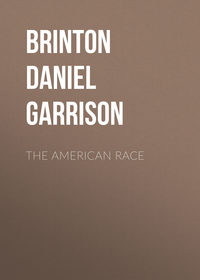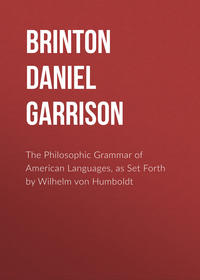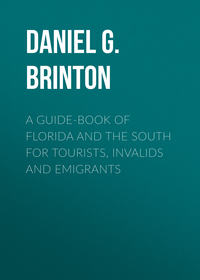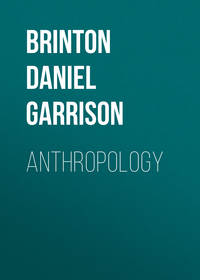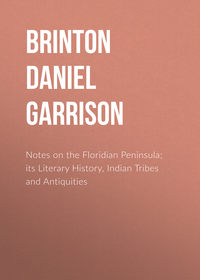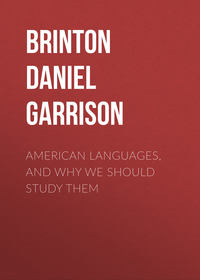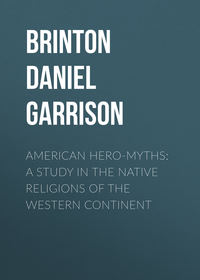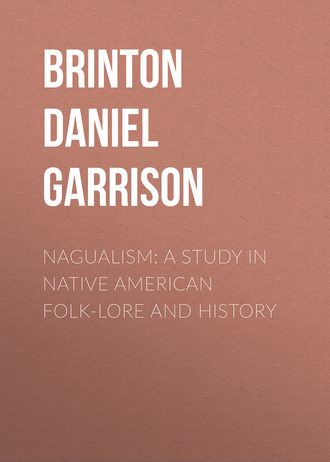 полная версия
полная версияNagualism: A Study in Native American Folk-lore and History
100
Diccionario Universal, Appendice, ubi suprá.
101
‘Señor de los Animales.” Codex Telleriano-Remensis, Parte ii, Lam. iv.
102
See Dr. Seler’s minute description in the Compte Rendu of the Eighth Session of the Congrés International des Américanistes, pp. 588, 589. In one of the conjuration formulas given by de la Serna (Manual de Ministros, p. 212) the priest says: “Yo soy el sacerdote, el dios Quetzalcoatl, que se bajará al infierno, y subiré á lo superior, y hasta los nueve infiernos.” This writer, who was very competent in the Nahuatl, translates the name Quetzalcoatl by “culebra con cresta” (id., p. 171), an unusual, but perhaps a correct rendering.
103
His words here are somewhat obscure. They are, “El baptismo de fuego, en donde las ponen los sobre nombres que llaman yahuiltoca, quando nacen.” This may be translated, “The baptism of fire in which they confer the names which they call yahuiltoca.” The obscurity is in the Nahuatl, as the word toca may be a plural of tocaitl, name, as well as the verb toca, to throw upon. The passage is from the Camino del Cielo, fol. 100, verso.
104
Sahagun, Historia de la Nueva España, Lib. iv, cap. 25.
105
It is mentioned as useful for this purpose by the early physicians, Francisco Ximenes, Cuatro Libros de la Naturaleza, p. 144; Hernandez, Hist. Plant. Novæ Hispaniæ, Tom. ii, p. 200. Capt. Bourke, in his recent article on “The Medicine Men of the Apaches” (in Ninth Annual Report of the Bureau of Ethnology, p. 521), suggests that the yiahuitli of the Aztecs is the same as the “hoddentin,” the pollen of a variety of cat-tail rush which the Apaches in a similar manner throw into the fire as an offering. Hernandez, however, describes the yiahuitli as a plant with red flowers, growing on mountains and hill-sides – no species of rush, therefore. De la Serna says it is the anise plant, and that with it the natives perform the conjuration of the “yellow spirit” (conjuro de amarillo espiritado), that is, of the Fire (Manual de Ministros, p. 197).
106
From the verb apeua. Vetancurt’s description is in his Teatro Mexicano, Tom. i, pp. 462, 463 (Ed. Mexico, 1870).
107
His frequent references to it show this. See his Manual de Ministros, pp. 16, 20, 22, 24, 36, 40, 66, 174, 217, etc. The word tlecuixtliliztli is compounded of tlecuilli, the hearth or fireplace, and ixtliluia, to darken with smoke.
108
Duran, Historia de los Indios de la Nueva España, Tom. ii, p. 240. Sahagun adds that the octli was poured on the hearth at four separate points, doubtless the four cardinal points. Historia de Nueva España, Lib. i, cap. 18. De la Serna describes the same ceremony as current in his day, Manual de Ministros, p. 35. The invocation ran: – “Shining Rose, light-giving Rose, receive and rejoice my heart before the God.”
109
A copy of these strange “Books of Chilan Balam” is in my possession. I have described them in my Essays of an Americanist (Philadelphia, 1890).
110
See his remarks on “Apperception der Menschenzeugung als Feuerbereitung,” in the Zeitschrift für Völkerpsychologie, Bd. vi, s. 113, seq.
111
Sahagun, Historia de Nueva España, Lib. i, cap. 13. The Nahuatl text is more definite than the Spanish translation.
112
See my Myths of the New World, p. 154, seq.
113
In the Nahuatl language the word xihuitl (xiuitl) has four meanings: a plant, a turquoise, a year and a comet.
114
J. B. Carriedo, Estudios Historicos del Estado Oaxaqueño, Tom. i, p. 82, etc.
115
Alva, Confessionario en Lengua Mexicana, fol. 9.
116
Carriedo, Estudios Historicos, pp. 6, 7.
117
In the Revue d’ Ethnographie, Tom. iii, p. 313. Some very fine objects of this class are described by E. G. Squier, in his “Observations on the Chalchihuitl,” in the Annals of the Lyceum of Natural History, Vol. i (New York, 1869).
118
Diego Duran, Historia de los Indios de Nueva España, Tom. ii, p. 140.
119
In Kingsborough, Antiquities of Mexico, Vol. ii, Pl. 180. On the cross as a form derived from a tree see the observations of W. H. Holmes, in the Second Annual Report of the Bureau of Ethnology, pp. 270, 271.
120
“Au Mexique, le cadre croisé, la croix en sautoir, comme celle de St. André, avec quelques variantes, representait le signe de nativité, tonalli, la fête, le jour natal.” M. Aubin, in Boban, Catalogue Raisonnée de la Collection Goupil, Tom. i, p. 227. Both Gomara and Herrera may be quoted to this effect.
121
See a curious story from native sources in my Essays of an Americanist, pp. 171, 172. It adds that this change can be prevented by casting salt upon the person.
122
Benito Maria de Moxo, Cartas Mejicanas, p. 257; Landa, Cosas de Yucatan, p. 193.
123
Pedro de los Rios, in his notes to the Codex Vaticanus, published in Kingsborough’s great work, assigns the sign, cohuatl, the serpent, to “il membro virile, il maggio augurio di tutti gli altri.” It is distinctly so shown on the 75th plate of the Codex. De la Serna states that in his day some of the Mexican conjurors used a wand, around which was fastened a living serpent. Manual de Ministros, p. 37.
124
There is abundant evidence of this in certain plates of the Codex Troano, and there is also alleged to be much in the Codex Mexicanus of the Palais Bourbon. Writing about the latter, M. Aubin said as far back as 1841 – “le culte du lingam on du phallus n’etait pas etranger aux Mexicains, ce qu’ etablissent plusieurs documents peu connus et des sculptures découvertes depuis un petit nombre d’années.” His letter is in Boban, Catalogue Raisonné la Collection Goupil, Tom. ii, p. 207. On the frequent identification of the serpent symbol with the phallus in classical art, consult Dr. Anton Nagele’s article, “Der Schlangen-Cultus,” in the Zeitschrift für Völkerpsychologie, Band xvii, p. 285, seq.
125
Cf. G. Tarayre, Exploration Mineralogique des Regions Mexicaines, p. 233 (Paris, 1869), and Bulletin de la Sociétè d’Anthropologie de Paris, Juin, 1893.
126
Sources de l’ Histoire Primitive de Mexique, p. 81.
127
From zo, to join together. Compare my Essays of an Americanist, p. 417 (Philadelphia, 1890).
128
“El indio Mexicano es todavia idolatra.” F. Pimentel, La Situacion actual de la Raza Indigena de Mexico, p. 197.
129
The “holy souls” who are here appealed to by name are those of deceased ah-kih, or priests of the native cult.
130
The appeal is to Water, regarded as the universal Mother. The “skirt of precious stones” refers to the green of the precious green stones, a color sacred to water.
131
The question is addressed to the tonal.
132
The yellow enchantment is tobacco; the white, a cup of water.
133
That is, assigned the form of the nagual belonging to the sick man.
134
This appeal is directed to the Milky Way.
135
The threat is addressed to the tonal, to frighten it into returning.
136
The “shining spirit” is the Fire-god.
137
The yellow tobacco, prepared ceremonially in the manner indicated.
138
These are names of days in the native calendar which are invoked.
139
The priest speaks in the person of his god.
140
Referring to the Nahuatl belief that there are nine upper and nine under worlds.
141
See the Relation del Auto celebrado en Mexico, año de 1659 (Mexico, En la Imprenta del Santo Officio, 1659).
142
J. B. Carriedo, Estudios Historicos del Estado Oaxaqueno, Tom. i, pp. 8, 9 (Oaxaca, 1849). About 1640 a number of Indians in the province of Acapulco were put to death for having buried enchanted ashes beneath the floor of a chapel! (Serna, Manual de Ministros, p. 52.)
143
“Nagual ist in seiner correcten Form naoal ein echtes Quiché-Wort, ein Substantivum instrumentale, vom Stamme naó, wissen, erkennen. Naoal ist dasjenige, womit oder woran etwas, in diesem Falle das Schicksal des Kindes, erkannt wird, und hat mit dem mexikanischen nahualli (Hexe), mit dem man es vielleicht in Verbindung bringen möchte, nichts zu schaffen.” Guatemala, s. 238.
144
The Abbé Brasseur observes: “Le mot nahual, qui vet dire toute science, ou science de tout, est fréquemment employé pour exprimer la sorcellerie chez ces populations.” Bulletin de la Sociétè de Géographie, 1857, p. 290. In another passage of his works the speculative Abbé translates naual by the English “know all,” and is not averse to believing that the latter is but a slight variant of the former.
145
See an article by me, entitled “On the Words ‘Anahuac’ and ‘Nahuatl,’” in the American Antiquarian, for November, 1893.
146
Manual de Ministros, p. 50.
147
Jesus Sanchez, Glosario de Voces Castellanas derivadas del Idioma Nahuatl, sub voce.
148
“Nagual– el lugar, rincon, cajon, nambira, etc., donde guarda sus talismanes y trajes de encanta la bruja.” Berendt, La Lengua Castellana de Nicaragua, MS.
149
Emetorio Pineda, Description Geografica de Chiapas y Soconusco, p. 23 (Mexico, 1845).
150
See his article “Wer-wolf,” in his Ethnographische Parallelen und Vergleiche, p. 62, seq.
151
Richard Andrée, ibid., ss. 63, 64.
152
See Alfred Maury, La Magie et l’ Astrologie, pp. 88, 89, 267, etc.
153
In the Notice Preliminaire to the second part of his work, La Magie et l’ Astrologie dans l’ Antiquité et au Moyen Age, Mr. Alfred Maury admirably sums up the scientific resources at our command for explaining the mystical phenomena of experience, without denying their reality as actual occurrences.




